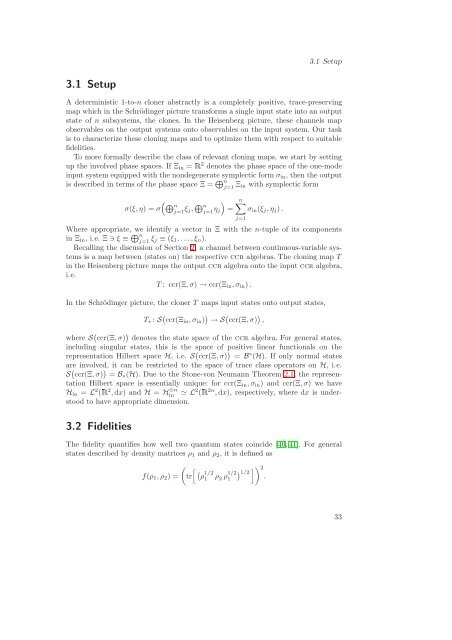Quantum Information Theory with Gaussian Systems
Quantum Information Theory with Gaussian Systems
Quantum Information Theory with Gaussian Systems
Create successful ePaper yourself
Turn your PDF publications into a flip-book with our unique Google optimized e-Paper software.
3.1 Setup<br />
3.1 Setup<br />
A deterministic 1-to-n cloner abstractly is a completely positive, trace-preserving<br />
map which in the Schrödinger picture transforms a single input state into an output<br />
state of n subsystems, the clones. In the Heisenberg picture, these channels map<br />
observables on the output systems onto observables on the input system. Our task<br />
is to characterize these cloning maps and to optimize them <strong>with</strong> respect to suitable<br />
fidelities.<br />
To more formally describe the class of relevant cloning maps, we start by setting<br />
up the involved phase spaces. If Ξin =Ê2 denotes the phase space of the one-mode<br />
input system equipped <strong>with</strong> the nondegenerate symplectic form σin, then the output<br />
is described in terms of the phase space Ξ = n<br />
j=1 Ξin <strong>with</strong> symplectic form<br />
n σ(ξ, η) = σ j=1ξj, n j=1ηj <br />
=<br />
n<br />
σin(ξj, ηj).<br />
Where appropriate, we identify a vector in Ξ <strong>with</strong> the n-tuple of its components<br />
in Ξin, i.e. Ξ ∋ ξ ≡ n<br />
j=1 ξj ≡ (ξ1, . . . , ξn).<br />
Recalling the discussion of Section 2, a channel between continuous-variable systems<br />
is a map between (states on) the respective ccr algebras. The cloning map T<br />
in the Heisenberg picture maps the output ccr algebra onto the input ccr algebra,<br />
i.e.<br />
T : ccr(Ξ, σ) → ccr(Ξin, σin).<br />
In the Schrödinger picture, the cloner T maps input states onto output states,<br />
j=1<br />
T∗: S ccr(Ξin, σin) → S ccr(Ξ, σ) ,<br />
where S ccr(Ξ, σ) denotes the state space of the ccr algebra. For general states,<br />
including singular states, this is the space of positive linear functionals on the<br />
representation Hilbert space H, i.e. S ccr(Ξ, σ) = B ∗ (H). If only normal states<br />
are involved, it can be restricted to the space of trace class operators on H, i.e.<br />
S ccr(Ξ, σ) = B∗(H). Due to the Stone-von Neumann Theorem 2.1, the representation<br />
Hilbert space is essentially unique: for ccr(Ξin, σin) and ccr(Ξ, σ) we have<br />
Hin = L 2 (Ê2 , dx) and H = H ⊗n<br />
in ≃ L2 (Ê2n , dx), respectively, where dx is understood<br />
to have appropriate dimension.<br />
3.2 Fidelities<br />
The fidelity quantifies how well two quantum states coincide [40, 41]. For general<br />
states described by density matrices ρ1 and ρ2, it is defined as<br />
f(ρ1, ρ2) =<br />
ρ1/2 tr 1 ρ2 ρ 1/2<br />
<br />
1/2<br />
1<br />
2 .<br />
33
















